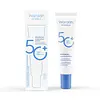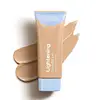Wardah UV Shield Physical Sunscreen Serum SPF 50+ PA++++ Versus Wardah Lightening Fresh BB Tint SPF 32
What's inside
What's inside
 Key Ingredients
Key Ingredients

 Benefits
Benefits

 Concerns
Concerns

No concerns
 Ingredients Side-by-side
Ingredients Side-by-side

Water
Skin ConditioningZinc Oxide
Cosmetic ColorantC12-15 Alkyl Benzoate
AntimicrobialPropanediol
SolventMaleated Soybean Oil Glyceryl/Octyldodecanol Esters
Trisiloxane
Skin ConditioningBiosaccharide Gum-1
HumectantDibutyl Adipate
EmollientHydroxyethyl Acrylate/Sodium Acryloyldimethyl Taurate Copolymer
Emulsion StabilisingBisabolol
MaskingGlycerin
HumectantAllantoin
Skin ConditioningAvena Sativa Kernel Flour
AbrasiveCaprylhydroxamic Acid
Phenoxyethanol
PreservativeArtemisia Capillaris Flower Extract
Skin ConditioningHouttuynia Cordata Extract
Skin ConditioningHaberlea Rhodopensis Leaf Extract
Skin ConditioningCamellia Sinensis Leaf Extract
AntimicrobialPolymethylsilsesquioxane
1,2-Hexanediol
Skin ConditioningArachidyl Alcohol
EmollientButylene Glycol
HumectantTriethoxycaprylylsilane
Polyacrylate Crosspolymer-6
Emulsion StabilisingPolyhydroxystearic Acid
EmulsifyingBehenyl Alcohol
EmollientChlorphenesin
AntimicrobialArachidyl Glucoside
EmulsifyingWater, Zinc Oxide, C12-15 Alkyl Benzoate, Propanediol, Maleated Soybean Oil Glyceryl/Octyldodecanol Esters, Trisiloxane, Biosaccharide Gum-1, Dibutyl Adipate, Hydroxyethyl Acrylate/Sodium Acryloyldimethyl Taurate Copolymer, Bisabolol, Glycerin, Allantoin, Avena Sativa Kernel Flour, Caprylhydroxamic Acid, Phenoxyethanol, Artemisia Capillaris Flower Extract, Houttuynia Cordata Extract, Haberlea Rhodopensis Leaf Extract, Camellia Sinensis Leaf Extract, Polymethylsilsesquioxane, 1,2-Hexanediol, Arachidyl Alcohol, Butylene Glycol, Triethoxycaprylylsilane, Polyacrylate Crosspolymer-6, Polyhydroxystearic Acid, Behenyl Alcohol, Chlorphenesin, Arachidyl Glucoside
Water
Skin ConditioningEthylhexyl Methoxycinnamate
UV AbsorberCyclopentasiloxane
EmollientButylene Glycol
HumectantIsododecane
EmollientCaprylyl Methicone
Skin ConditioningNiacinamide
SmoothingDimethicone
EmollientEthylhexyl Palmitate
EmollientLauryl PEG-9 Polydimethylsiloxyethyl Dimethicone
Skin ConditioningPEG-10 Dimethicone
Skin ConditioningTitanium Dioxide
Cosmetic ColorantStearic Acid
CleansingDimethicone Crosspolymer
Emulsion StabilisingSodium Chloride
MaskingTriethylhexanoin
MaskingZinc Oxide
Cosmetic ColorantDisteardimonium Hectorite
StabilisingSilica
AbrasiveCyclohexasiloxane
EmollientPropylene Glycol
HumectantPolyhydroxystearic Acid
EmulsifyingPhenoxyethanol
PreservativeDimethicone/Vinyl Dimethicone Crosspolymer
Skin ConditioningAloe Barbadensis Leaf Extract
EmollientPropylene Carbonate
SolventTriethoxycaprylylsilane
Aluminum Hydroxide
EmollientNylon-12
Tocopheryl Acetate
AntioxidantGlycerin
HumectantAllantoin
Skin ConditioningAscorbyl Tetraisopalmitate
AntioxidantEthylhexylglycerin
Skin ConditioningDisodium EDTA
Sodium Hyaluronate
HumectantBHT
AntioxidantTrimethylsiloxysilicate
EmollientGlycyrrhiza Glabra Root Extract
BleachingCarbomer
Emulsion StabilisingPolysorbate 20
EmulsifyingPotassium Sorbate
PreservativeSodium Benzoate
MaskingTocopherol
AntioxidantPalmitoyl Pentapeptide-4
Skin ConditioningCI 77891
Cosmetic ColorantCI 77492
Cosmetic ColorantCI 77491
Cosmetic ColorantCI 77499
Cosmetic ColorantWater, Ethylhexyl Methoxycinnamate, Cyclopentasiloxane, Butylene Glycol, Isododecane, Caprylyl Methicone, Niacinamide, Dimethicone, Ethylhexyl Palmitate, Lauryl PEG-9 Polydimethylsiloxyethyl Dimethicone, PEG-10 Dimethicone, Titanium Dioxide, Stearic Acid, Dimethicone Crosspolymer, Sodium Chloride, Triethylhexanoin, Zinc Oxide, Disteardimonium Hectorite, Silica, Cyclohexasiloxane, Propylene Glycol, Polyhydroxystearic Acid, Phenoxyethanol, Dimethicone/Vinyl Dimethicone Crosspolymer, Aloe Barbadensis Leaf Extract, Propylene Carbonate, Triethoxycaprylylsilane, Aluminum Hydroxide, Nylon-12, Tocopheryl Acetate, Glycerin, Allantoin, Ascorbyl Tetraisopalmitate, Ethylhexylglycerin, Disodium EDTA, Sodium Hyaluronate, BHT, Trimethylsiloxysilicate, Glycyrrhiza Glabra Root Extract, Carbomer, Polysorbate 20, Potassium Sorbate, Sodium Benzoate, Tocopherol, Palmitoyl Pentapeptide-4, CI 77891, CI 77492, CI 77491, CI 77499
 Reviews
Reviews

Ingredients Explained
These ingredients are found in both products.
Ingredients higher up in an ingredient list are typically present in a larger amount.
Allantoin is a soothing ingredient known for its protective and moisturizingg properties. Because of this, it is often added to products with strong active ingredients.
Studies show higher concentrations of this ingredient can promote wound healing.
Though it can be derived from the comfrey plant, allantoin is produced synthetically for cosmetic products to ensure purity.
Learn more about AllantoinButylene Glycol (or BG) is used within cosmetic products for a few different reasons:
Overall, Butylene Glycol is a safe and well-rounded ingredient that works well with other ingredients.
Though this ingredient works well with most skin types, some people with sensitive skin may experience a reaction such as allergic rashes, closed comedones, or itchiness.
Learn more about Butylene GlycolGlycerin is already naturally found in your skin. It helps moisturize and protect your skin.
A study from 2016 found glycerin to be more effective as a humectant than AHAs and hyaluronic acid.
As a humectant, it helps the skin stay hydrated by pulling moisture to your skin. The low molecular weight of glycerin allows it to pull moisture into the deeper layers of your skin.
Hydrated skin improves your skin barrier; Your skin barrier helps protect against irritants and bacteria.
Glycerin has also been found to have antimicrobial and antiviral properties. Due to these properties, glycerin is often used in wound and burn treatments.
In cosmetics, glycerin is usually derived from plants such as soybean or palm. However, it can also be sourced from animals, such as tallow or animal fat.
This ingredient is organic, colorless, odorless, and non-toxic.
Glycerin is the name for this ingredient in American English. British English uses Glycerol/Glycerine.
Learn more about GlycerinPhenoxyethanol is a preservative that has germicide, antimicrobial, and aromatic properties. Studies show that phenoxyethanol can prevent microbial growth. By itself, it has a scent that is similar to that of a rose.
It's often used in formulations along with Caprylyl Glycol to preserve the shelf life of products.
Polyhydroxystearic Acid is a soft wax made from castor oil.
It is is a texture thickener, emulsifier, and film-former. Emulsifiers prevent ingredients from separating, such as oils and waters.
Polyhydroxystearic Acid may not be fungal acne safe.
Learn more about Polyhydroxystearic AcidTriethoxycaprylylsilane is a silicone used to bind and stabilize ingredients.
As an emulsifier, it helps prevent ingredients from separating. This can help elongate the shelf life of products.
Triethoxycaprylylsilane is often used to coat mineral sunscreens ingredients to help give a better feel. It also helps reduce oxidative stress in sunscreens.
Learn more about TriethoxycaprylylsilaneWater. It's the most common cosmetic ingredient of all. You'll usually see it at the top of ingredient lists, meaning that it makes up the largest part of the product.
So why is it so popular? Water most often acts as a solvent - this means that it helps dissolve other ingredients into the formulation.
You'll also recognize water as that liquid we all need to stay alive. If you see this, drink a glass of water. Stay hydrated!
Learn more about WaterZinc Oxide is a mineral broad-spectrum UV filter; it is the broadest UVA and UVB reflector approved by the FDA. It also has skin protectant and skin soothing properties.
Zinc oxide is one of the most effective broad-spectrum UV filters. It protects against UVB, UVAII, and UVAI. In comparison to its counterpart titanium dioxide, zinc oxide provides uniform and extended UVA protection.
Another great benefit? This ingredient is highly photostable so it won't degrade easily under sunlight.
A common myth is that mineral UV filters are widely believed to primarily reflect UV light.
However, modern research shows titanium dioxide absorbs UV radiation like chemical filters (~95% absorption & 5% reflection).
Zinc oxide has great skin soothing properties so you'll likely find this in sunscreens formulated for sensitive skin or babies/children. It is unlikely to cause "eye sting" like other sunscreen ingredients.
Regulatory agencies consider zinc oxide to be non-toxic and safe. It has also been shown to not penetrate the skin.
Unfortunately, this ingredient does leave a visible white cast. This is why mineral sunscreens are often less cosmetically elegant than chemical or hybrid ones.
In cosmetics, zinc oxide can be found in both non-nano and nano-sized forms. The nano version is used to reduce white cast and improve the texture of sunscreen formulas.
There are ongoing concerns surrounding nano-zinc oxide's impact on marine ecosystems and whether it can be absorbed into skin.
Regarding marine ecosystems and coral reefs, there is no conclusive evidence that any form of zinc oxide (or any other sunscreen ingredients) will cause harm. The science is still developing but many consumers are keeping a close eye on this issue.
Please note, many destinations have reef-safety sunscreen rules. For instance, the U.S. Virgin Islands advises all visitors to use non-nano mineral sunscreens.
There has also been some stir about whether micronized or nano zinc oxide has potential photoxicity and absorption through the skin/lungs.
An in-vitro (done in a test tube or petri dish) study demonstrated micronized zinc oxide to have potential phototoxicity. There's no need to fret; the EU Commission's Scientific Committee on Consumer Safety has stated, "The relevance of these findings needs to be clarified by appropriate investigations in vivo." Or in other words, further studies done on living organisms are needed to prove this.
Current research shows zinc oxide nanoparticles do not penetrate intact or sunburned skin. They either remain on the surface or in the outermost layer of dead skin (stratum corneum).
Zinc oxide is one of only two classified mineral UV filters with titanium dioxide being the other one.
Fun fact: Zinc has been used throughout history as an ingredient in paint and medicine. An Indian text from 500BC is believed to list zinc oxide as a salve for open wound. The Ancient Greek physician Dioscorides has also mentioned the use of zinc as an ointment in 1AD.
Learn more about Zinc Oxide